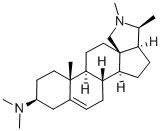[1] BINA S SIDDIQUI. Antimicrobial activity of the methanolic bark extract of Holarrhena pubescens (Buch. Ham), its fractions and the pure compound conessine.[J]. Natural Product Research, 2012, 26 11: 987-992. DOI:
10.1080/14786419.2010.537268[2] De Souza, F.I., Zumiotti, A.V., and Da Silva, C.F. Neuregulins 1-α and 1-β on the regeneration the peripheral nerves[J]. Acta Ortop Bras.
[3] VIRENDRA K DUA. Anti-malarial property of steroidal alkaloid conessine isolated from the bark of Holarrhena antidysenterica.[J]. Malaria Journal, 2013, 12: 194. DOI:
10.1186/1475-2875-12-194[4] LIANG SHEN. High-Throughput Screening and Identification of Potent Broad-Spectrum Inhibitors of Coronaviruses.[J]. Journal of Virology, 2019, 93 12. DOI:
10.1128/jvi.00023-19[5] CHEN ZHAO*. The Alkaloid Conessine and Analogues as Potent Histamine H3 Receptor Antagonists[J]. Journal of Medicinal Chemistry, 2008, 51 17: 5423-5430. DOI:
10.1021/jm8003625
